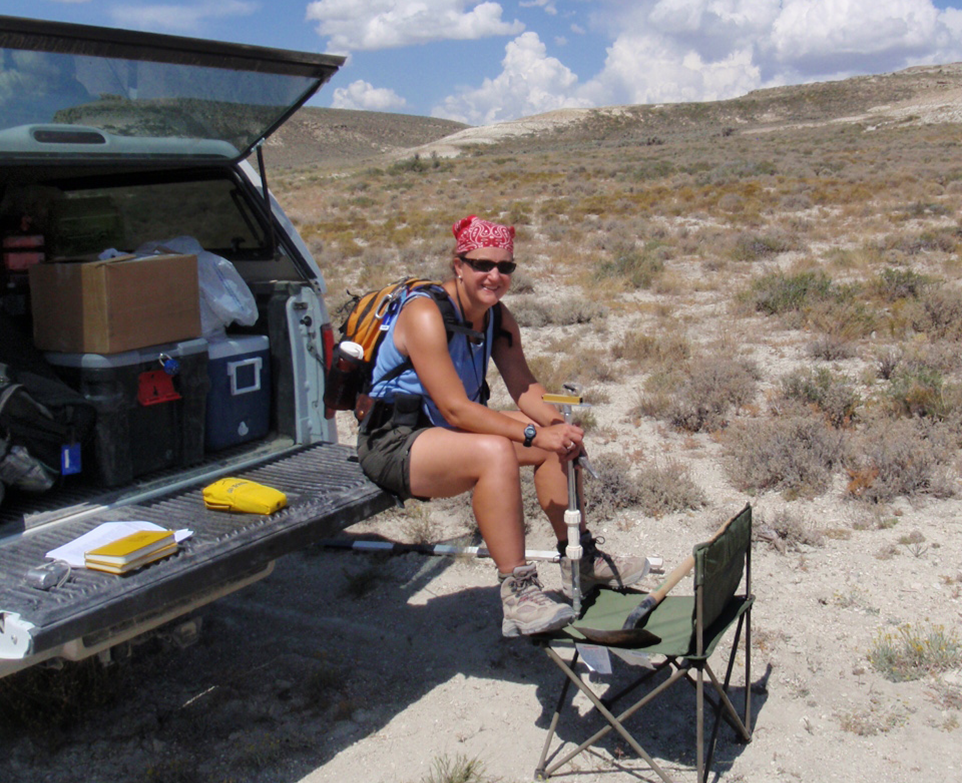
PhD and MS from U of Arizona, BS from College of Wooster
Field sites past & present: Lake Tanganyika, Lake Malawi, Eritrea, Oman, Indonesia, California, Wyoming, Nevada, Oregon, Bahamas
Writing a daily blog is way more work than I imagined! But it’s also the most rewarding thing I’ve done in the last five years, and I can already feel how much it has energized me to do science. I have had wonderful conversations with colleagues (male and female), found several new role models, and learned a whole lot more about some pretty inspiring field paleontologists. Today’s profile is a case in point. Before May 1, I had only interacted with Dr. Lisa Park Boush through her role as an NSF program officer. That changed the day I unveiled this blog, when I received a Facebook notification from Lisa. Lisa changed her profile picture to the totally bad-ass picture above, with the comment, “This is for Ellen Currano….” I knew immediately that this was a scientist after my own heart and that I had to learn more about her and feature her here!
Lisa studies ostracodes, also called “seed shrimp.” Still unfamiliar to you? Imagine a teeny shrimp inside a tiny clam shell (~1 mm, but can be up to 3 cm). Freshwater ostracodes are extremely useful for paleoenvironmental reconstruction. Because individual species often tolerate only small ranges in salinity, fossil assemblages can be used to infer past lake salinity. If we know how salinity changes, we can interpret lake level changes (more saline = lower lake level), which in turn can be used to reconstruct climate (lower lake levels = more arid conditions). Lisa has conducted live-dead studies of ostracodes from the African rift lakes to better understand the possible taphonomic biases affecting reconstructions of past climate, environment, and lake ecology. (If you didn’t understand that sentence, take a scavenger hunt for an earlier profile that explains some of these words!)
Freshwater ostracodes are also model organisms for evolutionary studies. Lakes are geographically restricted bodies of water, and the African rift lakes in particular are known for their high diversity and endemism (species found only in one place). Lisa’s work comparing the ostracod faunas of Lake Tanganyika and Lake Malawi demonstrates that a combination of lake longevity (older lakes steadily accumulate species) and lake level fluctuations (driving endemism and extinction) drive ostracod evolution and species diversity.
I’m an Africa-phile, so Lisa’s work on Tanganyika, Malawi, and the Danakil Depression are most fascinating to me. Lisa’s current research, however, is in the Bahamas, coring the saline ponds on San Salvador Island to construct high-resolution climate and hurricane records and to assess the impact these factors have on biodiversity. Climate models have suggested that hurricane intensity will increase with global warming, and so it is important to understand the impact of these storm events on ecosystems.
For more information on Dr. Lisa Park Boush, visit: http://www.lisaparkboush.com/home.html
Love your blog! It’s nice to be reminded of how many great women are in my field! Thanks so much!
Thanks for the tribute Ellen, but I must register my disapproval of you characterizing my service to NSF as “taking one for the team.” This is not a fair attribution to the hard work and dedicated service that the people who work at NSF do to enable research scientists like yourself and some of your readers to do the work they want to do. The National Science Foundation funds 20% of all scientific research in the United States and its mission is to provide the country with the intellectual infrastructure to make exciting discoveries to move science forward. I LOVED my time at NSF and am very proud of my service to the Foundation. I believe in it, the people who work there and the research community it serves. I felt that it was an honor to work there and had some of the best professional experiences of my career and made some of my best friends there. The United States should be proud and extremely gratified that it has the National Science Foundation to fund it scientists and make investments in its future.
Thank you so much for this comment, Lisa. After I finish writing here, I will revise the post. I am so sorry about my poor choice of wording. Your points are excellent and spot on, and, in retrospect, I know that I should have thought this post through better. No excuses.
I really love this blog series, Ellen! It’s really wonderful to see a broad profile of women in paleontology that excel in both the field and in leadership. I’m really optimistic about the future of our field as we have outstanding women beginning to take on really high profile and important roles in community service at higher and higher levels. Recently we’ve had women leading major paleontological societies, such as the Paleo Society and SVP, and Lisa’s work at NSF was of monumental importance. She led the charge to develop the Earth Life Transitions funding steam and ensured the prominent position of specimen based data in initiatives like Earth Cube. I look forward to the continued and increased service outstanding paleo women in leadership in the 21st century!